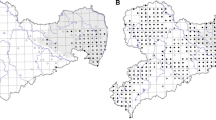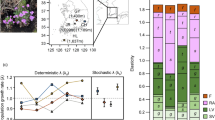Abstract
The aim with this study was to analyse the population dynamics ofSaxifraga cotyledon, a rare, long lived herb, withsemelparous rosettes. In Sweden, S. cotyledon grows infragmented habitats at high altitude and is classified as vulnerable accordingto the IUCN system. From a five year demographical study we estimatedpopulationgrowth rates and extinction risks for one small and one large subpopulation. Inthe small subpopulation deterministic matrix simulations showed largevariation,with two transitions projecting negative and two projecting positive populationgrowth. The large subpopulation also showed large variation, but all yearlytransitions projected positive population growth. In both subpopulationssurvival and growth contributed more than twice as much to population growthrates than did sexual reproduction, vegetative reproduction and the seed bankall taken together. In stochastic simulations the maximum likelihood growthestimator waslarger than 1 for both subpopulations. None of the two subpopulations sufferfrom high extinction rates and although the effect of demographic stochasticityincrease extinction risk in small populations it is enough with 70 individualsfor a viable population of S. cotyledon. Hence, for thestudied population of S. cotyledon, rareness per se is nota good indicator of vulnerability.
Similar content being viewed by others
References
Aronsson M. 1999. Rödlistade kärlväxter i Sverige - Artfakta [Swedish Red Data Book of Vascular Plants]. Artdatabanken, SLU, Uppsala.
Bierzychudek P. 1982. The demography of jack-in-the-pulpit, a forest perennial that changes sex. Ecological Monographs 52: 335–351.
Brook B.W., Lim L., Harden R. and Frankham R. 1997. Does population viability analysis software predict the behaviour of real populations? A retrospective study on the Lord Howe Island Woodhen (Tricholimnas sylvestris (Sclater)). Biological Conservation 82: 119–128.
Caswell H. 1989. Matrix population models: Construction, Analysis and Interpretation. Sinauer Associates Inc., Sunderland, Massachusetts.
Damman H. and Cain M.L. 1998. Population growth and viability analyses of the clonal woodland herb, Asarum canadense. Journal of Ecology 86: 13–26.
de Kroon H., Plaiser A., van Groenendael J. and Caswell H. 1986. Elasticity: the relative contribution of demographic parameters to population growth rates. Ecology 67: 1427–1431.
Eriksson O. 1994. Stochastic population dynamics of clonal plants: Numerical experiments with ramet and genet models. Ecological Research 9: 257–268.
Eriksson O. 1996. Population ecology and conservation: Some theoretical considerations with examples from the Nordic flora. Acta Universitatis Upsaliensis Symbolae Botanicae Upsalienses 31: 159–167.
Fearson S. and Burgman M.A. 1995. Correlations, dependency bounds and extinction risks. Biological Conservation 73: 101–105.
Floyd S.K. and Ranker T.A. 1998. Analysis of a transition matrix model for Guara neomexicana ssp. coloradensis (Onagraceae) reveals spatial and temporal demographic variability. International Journal of Plant Sciences 159: 853–863.
Franco M. and Silvertown J. 1994. On trade-offs, elasticities and the comparative method: a reply to Shea, Rees and Wood. Journal of Ecology 82: 958.
Kendall B.E. 1998. Estimating the magnitude of environmental stochasticity in survivourship data. Ecological Applications 8: 184–193.
Kokko H. and Ebenhard T. 1996. Measuring the strength of demographic stochasticity. Journal of Theoretical Biology 183: 169–178.
Lande R. 1988. Genetics and demography in biological conservation. Science 241: 1455–1460.
Lande R. 1993. Risks of population extinction from demographic and environmental stochasticity and random catastrophes. American Naturalist 142: 911–927.
Lande R. 1994. Risk of population extinction from fixation of new deleterious mutations. Evolution 48: 1460–1469.
Lande R. 1995. Mutation and conservation. Conservation Biology 9: 782–791.
Lande R. 1998. Risk of population extinction from fixation of deleterious and reverse mutations. Genetica 102-103: 21–27.
Menges E.S. 1998. Evaluating extinction risks in plant populations. In: Fiedler P.L. and Kareiva P.M. (eds), Conservation Biology. Chapman and Hall, New York.
Negrón-Ortiz V., Gorchov D.V. and Breckon G.J. 1996. Population structure in Zamia (Zamiaceae) in northern Puerto Rico, II. Seed germination and stage-structured population projection. International Journal of Plant Sciences 157: 605–614.
Newman D. and Pilson D. 1997. Increased probability of extinction due to decreased genetic effective population size: Experimental populations of Clarkia pulchella. Evolution 51: 354–362.
Nunney L. and Campbell K.A. 1993. Assessing minimum viable popualtion size: Demography meets population genetics. Trends in Ecology and Evolution 8: 234–240.
Shaffer M.L. 1987. Minimum viable populations: coping with uncertainty. In: Soulé M. (ed.), Viable Populations for Conservation. Cambridge University Press, Cambridge.
Shea K., Rees M. and Wood S.N. 1994. Trade-offs, elasticities and the comparative method. Journal of Ecology 82: 951–957.
Silvertown J., Franco M. and Menges E. 1996. Interpretation of elasticity matrices as an aid to the management of plant populations for conservation. Conservation Biology 10: 591–597.
Silvertown J., Franco M., Pisanty I. and Mendoza A. 1993. Comparative plant demography – relative importance of life-cycle components to the finite rate of increase in woody and herbaceous perennials. Journal of Ecology 81: 465–476.
Tanaka Y. 1997. Extinction of populations due to inbreeding depression with demographic disturbances. Researches on Population Ecology 39: 57–66.
Tuljapurkar S.D. and Orzack S.D. 1980. Population dynamics in variable environments. 1. Long run growth rates and extinction. Theoretical Population Biology 18: 314–342.
Taylor B.L. 1995. The reliability of using population viability analysis of risk classification of species. Conservation Biology 9: 551–558.
Webb D.A. and Gornall R.J. 1989. Saxifrages of Europe. Christofer Helm Ltd., London.
Wissel C. and Zaschke S.H. 1994. Stochastic birth and death processes describing minimum viable populations. Ecological modelling 76: 193–201.
Author information
Authors and Affiliations
Rights and permissions
About this article
Cite this article
Dinnétz, P., Nilsson, T. Population viability analysis of Saxifraga cotyledon, a perennial plant with semelparous rosettes. Plant Ecology 159, 61–71 (2002). https://doi.org/10.1023/A:1015593311183
Issue Date:
DOI: https://doi.org/10.1023/A:1015593311183




